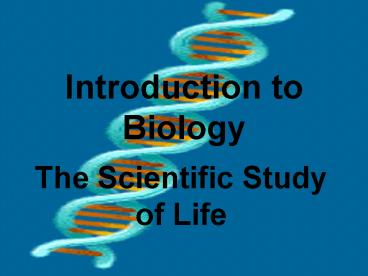Introduction to Biology - PowerPoint PPT Presentation
1 / 21
Title:
Introduction to Biology
Description:
Introduction to Biology The Scientific Study of Life Biology scientific study of life ranges from the molecular to the global microscope to ecosystem includes ... – PowerPoint PPT presentation
Number of Views:516
Avg rating:3.0/5.0
Title: Introduction to Biology
1
Introduction to Biology
- The Scientific Study of Life
2
Biology
- scientific study of life
- ranges from the molecular to the global
- microscope to ecosystem
- includes diversity of life now in the past
3
Biological Subjects
- Cytology
- Virology
- Embryology
- Anatomy
- Physiology
- Molecular Biology
- Genetics
- Botany
- Ichthyology
- Microbiology
- Zoology
- Evolutionary Biology
- Phylogeny
- Entomology
- Ecology
4
(No Transcript)
5
Organization
- 5 distinct kingdoms
- Archaea
- Bacteria
- Protista
- Fungi
- Plantae
- Animalia
6
Organization
- organisms are placed into a kingdom based on
their characteristic - all organisms in a kingdom possess the same
characteristics
7
Characteristics of Animalia Kingdom
- multicellular
- eukaryotic cells
- no cell walls
- heterotrophs-consumers
8
Characteristics of Life
- properties shared by all living things
- Cellular Organization
- Metabolism
- Homeostasis
- Growth Reproduction
- Heredity
9
Cellular Organization
- all living things are composed of cells
- tiny compartments surrounded by a membrane
- some are made up of only one cell
- others have trillions
10
Metabolism
- all living things use energy
- all energy originates from the sun
- plants use this energy in a process called
photosynthesis to make sugars - we eat plants or animals that have eaten plants
- energy is transferred to us
- transfer is metabolism
11
Homeostasis
- living things have processes that ensures
internal environment remains stable
12
Growth Reproduction
- all living things must grow
- they must reproduce
13
Heredity
- living things must have a genetic system found in
molecules of DNA (deoxyribonucleic acid) - determines properties of organism
- genetic code is used to pass information to
successive generations - transmission of traits is heredity
14
Organization of Life
- enormous range of life forms on the planet
- can be broken into hierarchical levels of
organization - Hierarchical organization
- means all organizational levels follow a
hierarchy from lower to higher - each level builds upon level above
- Top-biosphere
- includes all environments on Earth that support
life - next level down-ecosystem
- refers to all organisms living in a given area as
well as all non living physical aspects of
environment such as water, soil, sunlight, etc - relationship of organism to its environment is
studied in the branch of biology called ecology - below ecosystem-community
- all organisms that inhabit a given ecosystem
- Population
- interacting group of individuals of one species
- one individual of a species is organism
15
(No Transcript)
16
Hierarchy of Organization of Individual
- Chemical or Molecular
- Atoms?molecules
- Cells
- basic unit of structure and function in living
things - Tissues
- made of cells similar in structure function
working together to perform a specific activity4
basic tissues connective, epithelial, muscle,
and nerve - Organs
- made up of tissues that work together to perform
a specific activity - Examples - heart, brain, skin, etc.
- Organ Systems groups of two or more tissues
working together to perform a specific
function Human body has 11 organ systems -
circulatory, digestive, endocrine, excretory - (urinary), immune (lymphatic),
integumentary, muscular, nervous, reproductive, - respiratory skeletal
- Organisms entire living things that can carry
out all basic life processes - take in materials, release energy from food,
release wastes, grow, respond to the environment
reproduce usually made up of organ systems,
but an organism may be made up of only one cell
17
(No Transcript)
18
(No Transcript)
19
Study of Biology
- special way of thinking
- uses empirical or scientific method
- self-correcting process for asking questions
observing natures answers - separates science from philosophy
20
Parts of the Scientific Method
- Observations
- made in the real world
- Question
- leads to a question about those observations
- Hypothesis
- testable assumption or prediction
- Test hypothesis
- conduct research
- Reaffirm theory
- reaffirm or disaffirm theory in relation to
outcome of research
21
(No Transcript)































